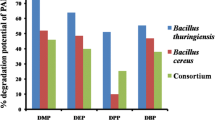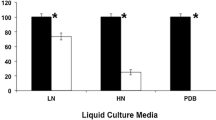Abstract—
The ability of the white-rot fungus Peniophora lycii LE-BIN 2142 to degrade such phthalic acid esters (PAEs) as diethyl phthalate (DEP), dibutyl phthalate (DBP), di(2-ethylhexyl) phthalate (DEHP), diisobutyl phthalate (DiBP), and n-butylbenzyl phthalate (BBP) was studied. It was shown that DEHP was most efficiently biodegraded by the fungus (over 98% on day 6 of cultivation). The residual content of DBP and DiBP in the culture liquid of the fungus at the end of cultivation (10 days) was ~17–18%. BBP turned out to be the most difficult-to-degrade compound: its residual content on day 10 of P. lycii cultivation was ~40%. DEP was resistant to fungal biodegradation and exhibited a toxic effect at 1.5 g/L: the rate of radial growth of the fungus on agar decreased threefold compared to the control, and the amount of fungal biomass during liquid-phase submerged cultivation decreased by about 1.5 times. During the cultivation of P. lycii on media with PAEs, an increase in esterase activity by about 2 times and a significant decrease (by 2–4 times) in oxidase activity was shown compared to the control medium without phthalates.



Similar content being viewed by others
REFERENCES
Ahmadi, E., Yousefzadeh, S., Ansari, M., Ghaffari, H.R., Azari, A., Miri, M., Nabizadeh, A.M.R., Kakavandi, B., Ahmadi, P., Badi, M.Y., Gholami ,M., Sharafi, K., Karimaei, M., Ghoochani, M., Brahmand, M.B., et al., Performance, kinetic, and biodegradation pathway evaluation of anaerobic fixed film fixed bed reactor in removing phthalic acid esters from wastewater, Sci. Rep., 2017, vol. 7, p. 41020. https://doi.org/10.1038/srep41020
Ahuactzin-Perez, M., Tlecuitl-Beristain, S., García-Davila, J., Santacruz-Juárez, E., González-Pérez, M., Gutiérrez-Ruíz, M.C., and Sánchez, C., Mineralization of high concentrations of the endocrine disruptor dibutyl phthalate by Fusarium culmorum, 3 Biotech., 2018, vol. 8, no. 42, pp. 1–10. https://doi.org/10.1007/s13205-017-1065-2
Akerman-Sanchez, G. and Rojas-Jimenez, K. Fungi for the bioremediation of pharmaceutical-derived pollutants: a bioengineering approach to water treatment, Environ. Adv., 2021, vol. 4. 100071. https://doi.org/10.1016/j.envadv.2021.100071
Boll, M., Geiger, R., Junghare, M., and Schink, B., Microbial degradation of phthalates: biochemistry and environmental implications, Environ. Microbiol. Rep., 2020, vol. 12, pp. 3–15. https://doi.org/10.1111/1758-2229.12787
Brenelli, L.B., Persinoti, G.F., Franco Cairo, J.P.L., Liberato, M.V., Gonçalves, T.A., Otero, I.V.R., Mainardi, P.H., Felby, C., Sette, L.D., and Squina, F.M., Novel redox-active enzymes for ligninolytic applications revealed from multiomics analyses of Peniophora sp. CBMAI 1063, a laccase hyper-producer strain, Sci. Rep., 2019, vol. 9, p. 17564. https://doi.org/10.1038/s41598-019-53608-1
Carstens, L., Cowan, A.R., Seiwert, B., and Schlosser, D., Biotransformation of phthalate plasticizers and bisphenol A by marine-derived, freshwater, and terrestrial fungi, Front. Microbiol., 2020, vol. 11, p. 317. https://doi.org/10.3389/fmicb.2020.00317
Chang, B.V., Yang, C.P., and Yang, C.W., Application of fungus enzymes in spent mushroom composts from edible mushroom cultivation for phthalate removal, Microorganisms, 2021, vol. 9, p. 1989. https://doi.org/10.3390/microorganisms9091989
Das, M.T., Kumar, S.S., Ghosh, P., Shah, G., Malyan, S.K., Bajar, S., Thakur, I.S., and Singh, L., Remediation strategies for mitigation of phthalate pollution: challenges and future perspectives, J. Hazard. Mater., 2021, vol. 409, p. 124496. https://doi.org/10.1016/j.jhazmat.2020.124496
de Souza Machado, A.A., Lau, C.W., Kloas, W., Bergmann, J., Bachelier, B.J., Faltin, E., Becker, R., Görlich, A.S., and Rillig, M.C., Microplastics can change soil properties and affect plant performance, Environ. Sci. Technol., 2019, vol. 53, pp. 6044−6052. https://doi.org/10.1021/acs.est.9b01339
Dutta, S., Haggerty, D.K., Rappolee, D.A., and Ruden, D.M., Phthalate exposure and long-term epigenomic consequences: a review, Front. Genet., 2020, vol. 11, p. 405. https://doi.org/10.3389/fgene.2020.00405
Gao, D. and Wen, Z., Phthalate esters in the environment: a critical review of their occurrence, biodegradation, and removal during wastewater treatment processes, Sci. Total Environ., 2016, vol. 541, pp. 986–1001.
González-Márquez, A., Ahuactzin-Pérez, M., and Sánchez, C., Lentinula edodes grown on di(2-ethylhexyl)phthalate-containing media: mycelial growth and enzyme activities, BioResources, 2015, vol. 10, pp. 7898–7906. https://doi.org/10.15376/biores.10.4.7898-7906
Hofmann, U. and Schlosser, D., Biochemical and physicochemical processes contributing to the removal of endocrine-disrupting chemicals and pharmaceuticals by the aquatic ascomycete Phoma sp. UHH 5-1-03, Appl. Microbiol. Biotechnol., 2016, vol. 100, pp. 2381–2399. https://doi.org/10.1007/s00253-015-7113-0
Hwang, S., Choi, H.T., and Song, H., Biodegradation of endocrine-disrupting phthalates by Pleurotus ostreatus, J. Microbiol. Biotechnol., 2008, vol. 18, pp. 767–772.
Li, H., Dai, Q., Yang, M., Li, F., Liu, X., Zhou, M., and Qian, X., Unraveling consequences of soil micro- and nano-plastic pollution on soil-plant system: implications for nitrogen (N) cycling and soil microbial activity, Chemosphere, 2020, vol. 260, p. 127578. https://doi.org/10.1016/j.chemosphere.2020.127578
Ma, J., Yue, H., Li, H., Zhang, J., Zhang, Y., Wang, X., Gong, S., and Liu, G., Selective delignification of poplar wood with a newly isolated white‑rot basidiomycete Peniophora incarnata T‑7 by submerged fermentation to enhance saccharification, Biotechnol. Biofuels, 2021, vol. 14, p. 135. https://doi.org/10.1186/s13068-021-01986-y
Moiseenko, K.V., Glazunova, O.A., Shakhova, N.V., Savinova, O.S., Vasina, D.V., Tyazhelova, T.V., Psurtseva, N.V., and Fedorova, T.V., Fungal adaptation to the advanced stages of wood decomposition: insights from the Steccherinum ochraceum, Microorganisms, 2019, vol. 7, p. 527. https://doi.org/10.3390/microorganisms7110527
Naveen, K.V., Saravanakumar, K., Zhang, X., Anbazhagan, K., and Wang, M., Impact of environmental phthalate on human health and their bioremediation strategies using fungal cell factory—a review, Environ. Res., 2022, vol. 214, p. 113781. https://doi.org/10.1016/j.envres.2022.113781
Savinova, O.S., Shabaev, A.V., Glazunova, O.A., Eremin, S.A., and Fedorova, T.V., Biodestruction of phthalic acid esters by white rot fungi, Appl. Biochem. Microbiol., 2022a, vol. 58, pp. 598–612. https://doi.org/10.31857/S0555109922050142
Savinova, O.S., Shabaev, A.V., Glazunova, O.A., Moiseenko, K.V., and Fedorova, T.V., Benzyl butyl phthalate and diisobutyl phthalate biodegradation by white-rot fungus Trametes hirsuta, Appl. Biochem. Microbiol., 2022b, vol. 58, suppl. 1, pp. S113‒S125. https://doi.org/10.1134/S0003683822100118
Shabaev, A.V., Moiseenko, K.V., Glazunova, O.A., Savinova, O.S., and Fedorova, T.V., Comparative analysis of Peniophora lycii and Trametes hirsuta exoproteomes demonstrates “Shades of Gray” in the concept of white-rotting fungi, Int. J. Mol. Sci., 2022, vol. 23, p. 10322. https://doi.org/10.3390/ijms231810322
Shkaeva, I.E., Solntseva, S.A., Nikulia, O.S., Nikolaev, A.I., Dulov, S.A., and Zemlyanoi, A.V., Toxicity and danger of phthalates, Toksikol. Vestn., 2019, vol. 159, no. 6, pp. 3–9.
Sinitsyn, A.P, Gusakov, A.V., and Chernoglazov, V.M., Biokonversiya lignotsellyuloznykh materialov (Bioconversion of Lignocellulose Materials), Moscow: Mos. Gos. Univ., 1995.
Suárez-Segundo, J.L., Vazquez-Lopez, D., Torres-Garcia, J.L., Ahuactzin-Perez, M., Montiel-Martínez, N., Tlecuitl-Beristain, S., and Sánchez, C., Growth of colonies and hyphal ultrastructure of filamentous fungi grown on dibutyl phthalate and di(2-ethylhexyl)phthalate, Revista Mexicana de Ingeniería Química, 2013, vol. 12, pp. 499–504.
Tang, Y., Zhang, Y., Jiang, L., Yang, C., and Rittmann, B.E., Enhanced dimethyl phthalate biodegradation by accelerating phthalic acid di-oxygenation, Biodegradation, 2017, vol. 28, pp. 413–421. https://doi.org/10.1007/s10532-017-9805-x
Tran, H.T., Lin, C., Bui, H.-T., Nguyen, M.K., Cao, N.D.T., Mukhtar, H., Hoang, H.G., Varjani, S., Ngo, H.H., and Nghiem, L.D., Phthalates in the environment: characteristics, fate and transport, and advanced wastewater treatment technologies, Bioresour. Technol., 2022, vol. 344, p. 126249. https://doi.org/10.1128/jcm.02479
Weaver, J.A., Beverly, B.E.J., Keshava, N. Mudipalli, A., Arzuaga, X., Cai, C., Hotchkiss, A.K., Makris, S.L., and Yost, E.E., Hazards of diethyl phthalate (DEP) exposure: a systematic review of animal toxicology studies, Environ. Int., 2020, vol. 145, p. 105848. https://doi.org/10.1016/j.envint.2020.105848
Zhao, F., Wang, P., Lucardi, R.D., Su, Z., and Li, S., Natural sources and bioactivities of 2,4-di-tert-butylphenol and its analogs, Toxins, 2020, vol. 12, p. 35. https://doi.org/10.3390/toxins12010035
Funding
This research was funded by the Russian Science Foundation (grant no. 21-14-00306).
Author information
Authors and Affiliations
Corresponding author
Ethics declarations
Conflict of interests. The authors declare that they have no conflict of interest.
Statement on the welfare of animals. This article does not contain any studies involving animals or human participants performed by any of the authors.
Additional information
Translated by E. Babchenko
Rights and permissions
About this article
Cite this article
Savinova, O.S., Shabaev, A.V. & Fedorova, T.V. Biodegradation of Phthalic Acid Esters by the White-Rot Fungus Peniophora lycii. Microbiology 92, 427–433 (2023). https://doi.org/10.1134/S0026261723600222
Received:
Revised:
Accepted:
Published:
Issue Date:
DOI: https://doi.org/10.1134/S0026261723600222




